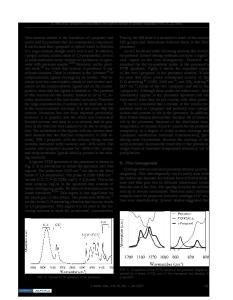Characterization of Epitaxial Pb(Zr x ,Ti 1-x )O 3 Thin Films with Composition Near the Morphotropic Phase Boundary
- PDF / 177,018 Bytes
- 6 Pages / 612 x 792 pts (letter) Page_size
- 43 Downloads / 348 Views
U13.4.1
CHARACTERIZATION OF EPITAXIAL Pb(Zrx,Ti1-x)O3 THIN FILMS WITH COMPOSITION NEAR THE MORPHOTROPIC PHASE BOUNDARY
Keisuke Saito PANalytical Application Laboratory, Sagamihara 228-0803, Japan Toshiyuki Kurosawa and Takao Akai PANalytical, Tokyo 108-0057, Japan Shintaro Yokoyama, Hitoshi Morioka, Takahiro Oikawa and Hiroshi Funakubo Tokyo Institute of Technology, Yokohama 226-8502, Japan ABSTRACT 200-nm-thick Pb(Zrx,Ti1-x)O3 (PZT) thin films with zirconium composition in the range from 0% to 65% were epitaxially grown on (001)c SrRuO3 (SRO)//SrTiO3 (STO) single crystal substrates by pulsed metalorganic chemical vapor deposition (pulsed MOCVD). Constituent crystallographic phases were characterized by high-resolution X-ray diffraction reciprocal space mapping. It was found that PZT thin films having zirconium composition from 45% to 60% show mixed tetragonal and pseudocubic phases and their lattice parameters remained constant in this composition range. INTRODUCTION Pb(Zrx,Ti1-x)O3 (PZT) with zirconium composition x close to the morphotropic phase boundary (MPB) of 0.54 has been receiving much attention regarding its application to microelectromechanical systems (MEMS) due to its large piezoelectric constant and electromechanical coupling factor [1,2]. PZT takes a tetragonal structure and a rhombohedral structure when x is below and above the MPB, respectively. In bulk ceramics, the coexistence of tetragonal and rhombohedral phases at around the MPB composition is well known, and more recently, a tetragonal and monoclinic mixed phase was proposed [3-6]. The constituent crystallographic phases are typically determined using Rietveld analysis of X-ray or neutron diffraction patterns. However, it is impossible to apply the Rietveld analysis to PZT in the form of thin film due to the problem of preferred orientation of the crystal. Preferred orientation reduces the number and changes the intensity of diffractions. We previously reported that X-ray diffraction reciprocal space mapping (XRD-RSM) is effective for determining the crystal structure and orientation of
U13.4.2
PZT thin film [7-10]. In the present study, we applied XRD-RSM to epitaxial PZT thin films with zirconium composition in the range from 0% to 65% and investigated crystal structures of PZT thin films with composition near the MPB. EXPERIMENTAL DETAILS 200-nm-thick PZT thin films were epitaxially grown on (001)c SRO//STO single crystal substrates at 580°C by pulsed metalorganic chemical vapor deposition (MOCVD) from Pb(C11H19O2), Zr(O・t-C4H9)4, Ti(O・i-C3H7)4 and O2 starting materials [11]. Film compositions were characterized using an X-ray fluorescent spectrometer (PANalytical PW2404). Constituent crystallographic phases and their relative volume fractions were determined by XRD-RSM measurement conducted using a PANalytical X’Pert PRO-MRD high-resolution X-ray diffractometer. Incident X-rays were monochromatized and made parallel using multilayer X-ray mirror and germanium single-crystal channel-cut collimator. More details on the experimental con
Data Loading...










